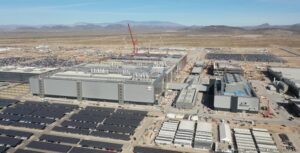Wafer production underway at TSMC’s Phoenix factory; Q1 earnings beat expectations

Taiwan Semiconductor Manufacturing Co. is making “significant progress” on its north Phoenix site with engineering wafer production already underway in its first factory still under construction, the company said on an earnings call Thursday.
C.C. Wei, TSMC’s chief executive, told analysts and investors on the earnings call the company began engineering wafer production for its N4 process technology in its first Arizona factory, or fab, earlier this month and is on track to begin volume production in the first half of 2025.
“We are confident that once we begin volume production, we will be able to deliver the same level of manufacturing quality and reliability in each of our fab(s) in Arizona as from our fab in Taiwan,” Wei said.
Each of the company’s three fabs in Arizona will feature a clean room area that’s double the size of a typical logical fab, Wei said.
Aiding in TSMC’s ambitious Arizona plans, The U.S. Department of Commerce on April 8 entered a nonbinding preliminary agreement with TSMC (NYSE: TSM) for a CHIPS Act award package that consists of $6.6 billion in grants and up to $5 billion in loans. Just down the road in Chandler, Intel Corp. also received a huge chunk of CHIPS Act funding earlier this year.
TSMC also plans to claim the Department of the Treasury’s Investment Tax Credit of up to 25% of $65 billion in capital expenditures, bringing the total federal commitment to more than $27 billion, the Business Journal previously reported.
The international semiconductor giant is increasing its investment in its Arizona fabs from $40 billion to $65 billion as it plans to build a third facility by the end of the decade that will produce 2-nanometer chips to power smartphones, data centers and artificial intelligence applications.
TSMC’s first Arizona fab will produce 4-nanometer FinFET process technologies, while its second fab will support strong AI-related demand and produce 2- and 3-nanometer process technologies for customers that include AMD, Apple, Nvidia and Qualcomm.
TSMC is expected to start operations in its second fab in 2028, followed by production in its third fab by the end of the decade.
The company’s Arizona fabs are expected to employ more than 6,000 workers, up from the 4,500 it initially anticipated. Entering April, the company has hired 2,200 workers, a TSMC spokeswoman told the Business Journal. TSMC did not provide a specific number of employees working inside the Arizona fab.
TSMC earnings beat Wall Street expectations
TSMC’s first-quarter earnings exceeded Wall Street expectations on Thursday as demand continues to rise for advanced computer chips used in AI applications.
“Our N2 technology leads our industry in addressing the insatiable need for energy-efficient computing, and almost all AI innovators are working with TSMC,” Wei said. “We are observing a high level of customer interest and engagement at N2 and expect the number of the new tape-outs from 2-nanometer technology in its first two years to be higher than both 3-nanometer and 5-nanometer in their first 2 years.”
Nonetheless, the company’s shares took a hit on Thursday as the company cast some doubts on the overall microchip market’s outlook. Barron’s reported that the company cut its forecast for overall market growth this year, excluding memory chips, to 10%, slightly better than it had forecast earlier in the year. TSMC shares were down nearly 5% at the close of trading to $132.27, a loss of $6.76 per share.
TSMC generated $18.8 billion in revenue during the first quarter, up 13% from the prior year. The company’s first-quarter revenue exceeded its previous forecast, which was between $18 billion to $18.8 billion.
TSMC’s quarterly revenue also beat the LSEG SmartEstimate of $6.7 billion, equivalent to $218.1 billion in New Taiwan dollars, Reuters reported.
TSMC expects its second quarter revenue between $19.6 billion and $20.4 billion, representing a 27.6% increase over the prior year.
“Moving into second quarter 2024, we expect our business to be supported by strong demand for our industry-leading 3-nanometer and 5-nanometer technologies, partially offset by continued smartphone seasonality,” Wei said.
